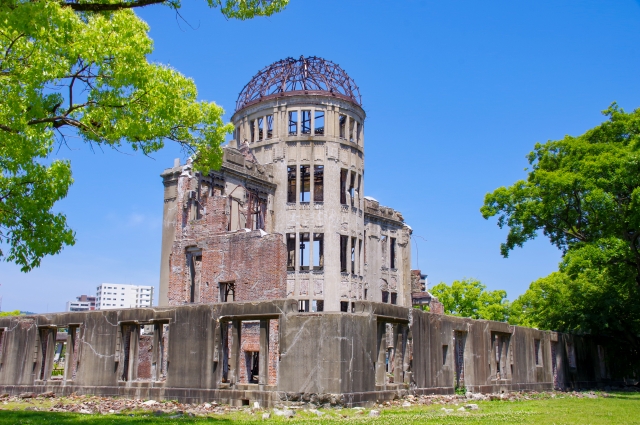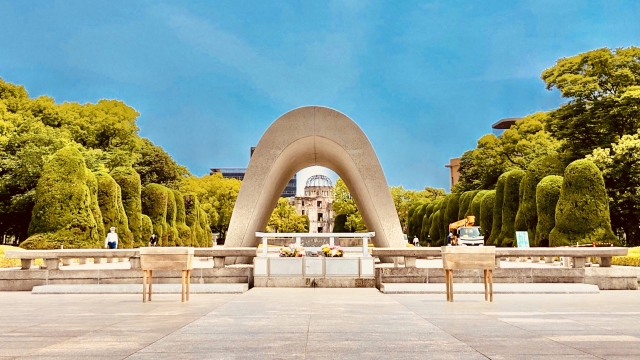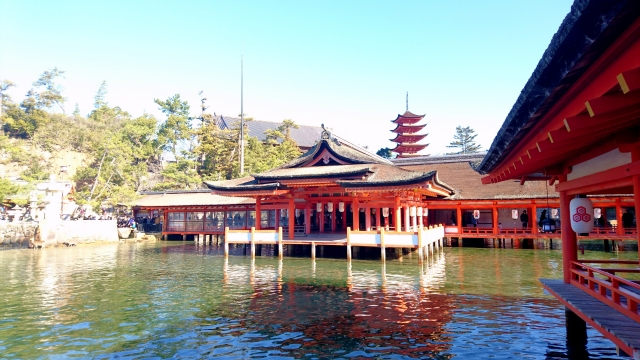
Today, August 6, is “Hiroshima Atomic Bomb Day,” 77 years after being exposed to radiation.
I believe that people should have their own ideas about war and nuclear weapons. However, the reason why I dare to write this article on this day is because I would like both foreigners and Japanese to actually go to the Peace Memorial Museum in front of the A-bomb Dome in Hiroshima once and think about what peace means to them.
Just My Thoughts
・As the only country in the world to have experienced the atomic bombings, we, as Japanese, need to hear from our ancestors about the horror of the atomic bombings and pass it on to future generations. Especially nowadays, people talk about the use of nuclear weapons so easily. I believe that we Japanese have a duty to appeal to the world to realize a peaceful world without nuclear weapons.
・I believe that there are war stories that Japanese people should know. When I studied abroad, I was shocked by the words of a teacher, and from there I changed my attitude toward war. I think that young people, especially those who will be in contact with many people from other countries, should learn what we did to other countries in the war, what they did to us, and what the world thinks about it, and each of them should have his or her own ideas about it.
・Shinkansen from Tokyo and Osaka
・Domestic flights from Narita and Haneda to Hiroshima Airport
Check here
Peace Memorial Park : located at the highest point of the delta where the old Ohta River (Honkawa River) splits into the Motoyasu River, and was established as a memorial to the victims of the atomic bomb and as a prayer for lasting world peace. This was the central downtown area of Hiroshima City from the Edo period (1603-1867) to the early Showa period (1926-1989), but it was instantly destroyed by the first atomic bomb dropped in human history on August 6, 1945. The park contains the Atomic Bomb Dome, Hiroshima Peace Memorial Museum, a number of monuments erected in the hope of peace, and a blue-green algae that was exposed to the atomic bomb.

Atomic Bomb Dome
The Atomic Bomb Dome was the first building to be hit by a nuclear weapon used in human history at the end of World War II. The A-bomb Dome, which stands almost exactly as it was at the time of the bombing, conveys the horrors of nuclear weapons and is a common monument to peace for all mankind that continues to emphasize the importance of the abolition of nuclear weapons and lasting peace in the world.
Hiroshima Peace Memorial Museum
The Peace Memorial Museum collects and exhibits artifacts left behind by A-bomb survivors, as well as photographs and other materials showing the devastation caused by the atomic bombing.
Itsukushima Shrine, Miyajima
Itsukushima (Miyajima) is an island where the island itself has been worshipped as a god since ancient times. Itsukushima Shrine, which stands mysteriously in the sea, was registered as a World Heritage site in 1996. It is also a shrine that many people have believed in, and is a popular tourist attraction that attracts many visitors from Japan and other countries throughout the four seasons.

Okonomiyaki:a kind of “snack” made by mixing flour with water and baking it with green onions, dried shrimp, red ginger, and other ingredients. It was not until after World War II that it was eaten as a meal. To compensate for the lack of nutrients, some innovations were made, such as adding cabbage, eggs, seafood, soba noodles, and udon noodles as ingredients, and the Hiroshima-style okonomiyaki of today was born. Okonomimura
Momiji-manju: A type of baked manju shaped like a maple tree, a specialty of Itsukushima, Hiroshima Prefecture. Shop: Nishiki-do , Momiji-do
Oyster :
Kakiya : The only restaurant on Miyajima that specializes in oyster dishes, serving only oysters. It is a 5-minute walk from Miyajima Pier.
Oyster House Fukuromachi Kaihei Shoten: An oyster house in the city where you can enjoy delicious oysters and good drinks. OPEN :5PM-11PM Closed Monday
Hiroshima Lemons : Hiroshima Prefecture, located on the warm Seto Inland Sea coast, produces the largest amount of lemons in Japan! You can enjoy a variety of lemon souvenirs.
Setoda Lemon Cake “Shimagokoro”
Setouchi Lemon Farm LEMOSCO : The tangy taste of chili peppers added to the sour lemon flavor makes this an addictive seasoning that will make you say “Yum! The seasoning is addictive.
【日本語抜粋】
【背景】今日、8月6日は被曝77年「広島原爆の日」です。戦争や核兵器について人それぞれの考え方があって良いと思っている。ただ、今回敢えて、この日にこの記事を挙げるのは、是非、外国人も日本人も一度、実際に広島の原爆ドームの前で、また、平和記念資料館へ行き、改めて平和とは何かを自身で考えてほしいと思ったからです。
私の考え
・世界唯一の被爆国として、日本人である私たちは、原爆の恐ろしさを先人たちより聞き、伝えていく必要がある。特に今、世の中では核兵器の使用を簡単に口にするようになっている。核兵器のない平和な世界の実現には私たち日本人には訴えていく義務があると思う。
・日本人には知るべき戦争の話があると私は思っている。海外に留学した際に、先生が言った言葉に衝撃を受け、そこから戦争に対する考え方を改めた。学校の社会の授業で学ぶことが全てではなく、外国の人々と接することが多くなるであろう若者には特に、我々が戦争で他国にしたこと、されたこと、それを世界がどう考えているかを学び、それぞれがそれに対して考えを持っているべきだと思っている。
【交通・アクセス】
東京、大阪から新幹線、または成田、羽田から広島空港への国内線の利用も可能
【ポイント】
・平和記念公園 : 旧太田川(本川)が元安川と分岐する三角州の最上流部に位置し、原爆死没者の慰霊と世界恒久平和を祈念して開設された都市公園です。
・原爆ドーム:第2次世界大戦末期に人類史上初めて使用された核兵器により、被爆した建物です。
・平和記念資料館 : 被爆者の遺品や被爆の惨状を示す写真や資料を収集・展示するととともに、広島の被爆前後の歩みや核時代の状況などについて紹介。
・宮島・厳島神社:古くから島そのものが神として信仰されていたという厳島(宮島)。その海上に神秘的に建っている嚴島神社は、1996年世界遺産に登録されました。
【food】
・お好み焼き:お好み村
小麦粉を水で溶き、ネギや干エビ、紅ショウガなどを入れて焼いたもので、おやつ」のような存在でした。食事として食べられるようになったのは、戦後のことで、栄養不足を補うために、具としてキャベツや卵、魚介類、そば、うどんを入れるなど工夫を重ね、今の広島風お好み焼が誕生した。
・もみじ饅頭:もみじをかたどった焼饅頭の一種であり、広島県厳島の名産品 にしき堂、紅葉堂
・牡蠣:
・牡蠣屋:宮島で唯一の、牡蠣のみを扱う牡蠣料理専門店です。宮島桟橋から徒歩5分ほど
・かき小屋袋町 海平商店 :美味しい牡蠣と美味しいお酒が飲める市内の牡蠣小屋。
・レモン : 温暖な瀬戸内沿岸にある広島県のレモン生産量は日本一!様々なレモン土産が楽しめます。
・瀬戸田:レモンケーキ「島ごころ」
・瀬戸内レモン農園 LEMOSCO:すっぱいレモンの風味に唐辛子のピリッとした辛さが加わり、「うまい!」とやみつきになる調味料。




コメント